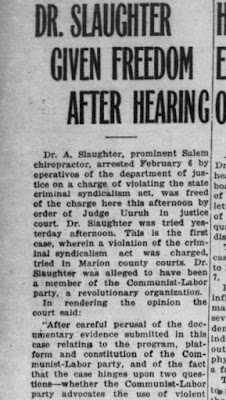 |
| "There are problems the market can't solve. Parking isn't one of them" |
 |
| Asphalt soteriology and asphalt socialism |
In the second half of the 20th century we hollowed out the city, and people would have gone further, killing the patient to "save" the patient.
 |
| Demolishing functional buildings for parking Between the McGilchrist Block and Masonic Building Statesman, January 23rd, 1968 (See the 1966 fire, also) |
As we depopulated downtown and those close-in neighborhoods, and conceived of downtown as a suburban-style "drive-to" destination, we lost the game. Reconceiving downtown as a mixed-use and walkable urban center whose primary users live in and near it, is the key to any renaissance. In this reading, free parking hinders rather than helps.
- "Girdling Downtown: Institutional Growth and the Etiolaton of Business" (2011)
- "Maybe ODFW Passing on Capitol Mall is a Good Thing" (2012)
- "Pringle Creek Urban Renewal District Nets Little over Inflation" (2012); interestingly, a just-published Portland audit of a residential urban renewal zone finds it also failed to increase property values over a nearby neighborhood and what might be expected from "natural" change. Our urban renewal programs really need a closer look and round of refinement so they better accomplish what they set out to do.
- "Capitol's 75th Anniversary Hoopla Yields Interesting History; 1938, as Now, Transitional" (2013)
- "Demolished Cooke-Patton House and the Civic Center Debate" (2013)
- All about the historic buildings we've lost for surface parking and parking structures. Good news? Two of the lots are finally getting built on. "Parking Craters and the Buildings that Preceded Them" (2016 and the site's most popular post all time! )
- "Parking Task Force Meets Tuesday" on the first meeting of the downtown parking task force. (2012)
- "Leaking Revenue: Free Parking Dazzles; Makes us Forget about People" (2012)
- "Really, We have Plenty of Parking Downtown" with map of vast amount of surface parking (2013)
- "City Council, July 22nd - Parking, Parking, Parking" Contesting the idea that opposing free parking means "I hate downtown" or "I want a dead downtown."(2013)
Anyway, since "socialism" loosely construed is going to be an issue and target in the upcoming election, the position here is that we need more "socialism" on things like affordable housing and health care, and we need more neoliberalism and market fundamentalism on things like road access, car storage, carbon fees, and basically all our autoism.
We should see the subsidies for our autoism, including our mania for free parking, as an instance of "asphalt socialism" and be more willing to critique them.
Here's a more serious instance of red-baiting from 100 years ago. A chiropractor who was interested in, and perhaps even active for, socialism was arrested and sent to trial in February 1920.
 |
| A chiropractor was arrested on Syndicalism charges February 8th, 1920 |
 |
| February 18th, 1920 |
 |
| Reds, Syndicalism, and Centralia Riot February 20th, 1920 |


No comments:
Post a Comment